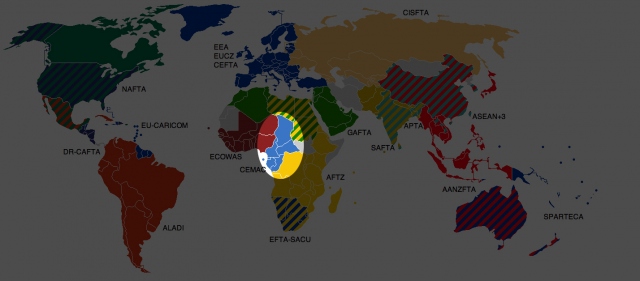The continent of Africa is perhaps the
most diverse landscape on the planet in terms of natural resources
and inhabitants. The Western perspective of Africa is likely so
colored by media reports of internal unrest, drought, and poverty
that one might be surprised to learn that some countries import and
export billions of dollars' worth of goods annually. Indeed, among
the nations that comprise the Economic and Monetary Community of
Central Africa, there thrive a number of economies working together
toward common goals to improve the region.

CEMAC has its roots in the Brazzaville
Treaty ratified in 1966, which established the free trade area and
eventually formed a common currency, the Central African Franc
(French is one of the primary languages in the region). A little
over a decade ago, the tenets of the CEMAC agreements took over the
original treaty.
The six member nations of the CEMAC
trade agreement include:
Cameroon - Since gaining
independence over fifty years ago, Cameroon has seen a steady
increase in its GDP. While fishing is a large industry, the nation's
exports are mainly comprised of petroleum and lumber and select
crops.
Central African Republic - This
landlocked nation relies primarily on agricultural industries to
maintain its GDP. Main export crops include tobacco, coffee, and
cotton, with nearly half of the goods traded to Japan.
Congo - The Republic of the
Congo is comprised mainly of rain forests that support their timber
industry, though petroleum exports play a sizable role in their
export output.
Gabon - Rich in oil fields,
Gabon exports several billion dollars' worth of petroleum product
to main trade partners Russia, the United States, and China
annually.
Equatorial Guinea - This nation
is somewhat new to oil mining, with reserves discovered in the last
fifteen years. Oil production has helped raise Equatorial Guinea's
profile and GDP, though forestry and agricultural industries are
also important to the economy.
Chad - Another oil-rich nation,
the bulk of Chad's exports are traded to the United States, which
has a large presence in the Republic via Exxon Mobil.
Within this Central African community,
goals include the establishment and growth of a common market to
benefit member nations, continued stability of the CFA Franc, and
harmonic political and social relations. Other goals set at the
establishment of CEMAC, such as the elimination of tariffs within
member nations' borders, however, have yet to be realized. Possible
reasons for the delay may include unstable political conditions or
external issues that downplay the CEMAC nations' merits and
promotional endeavors. It is possible with the establishment of ECCAS
(the Economic Community of Central African States), which will
succeed the CEMAC treaty, these countries will see long-term goals
come to fruition.
At present, the region's overall GDP
experiences a growth rate around four percent that may increase as
demands on prized resources increases. Growth projection for 2012
sets the region at six percent, dismissing rumors of a devalued
currency. One can hope this fortune is felt beyond this region's
borders.